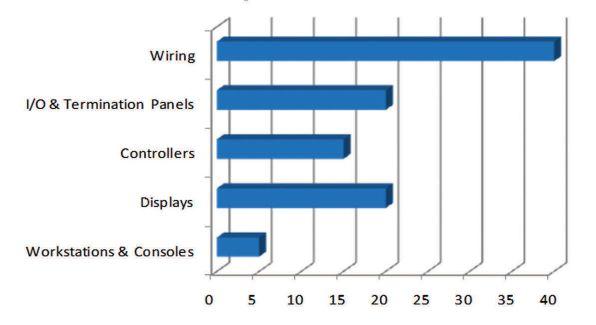
4 minute read
Think Again: Data flow, alarms simulation, cybersecurity, robotics
Data flow, alarms, simulation, cybersecurity, robotics
Control Engineering highlights automation, controls and instrumentation successes at www.controleng.com and in print.
Advertisement
Automation, controls, and instrumentations are critical, innovative, interesting and productive, and Control Engineering offers information on Boeing’s automation adjustments to its 737 Max (News, prior page) and developments on data flow, alarm design, digital twins and simulation efficiency, cybersecurity and robotic programming, among others.
Data flow optimization – Technology Update from Chris Adam, Purdue University: Current cloud technologies using automated decision making often only work for short and repeat tasks and workloads. The team created an optimal configuration to handle long-running, dynamic workloads, whether it be workloads from the ubiquitous sensor networks in connected farms or high-performance computing workloads from scientific applications or the current COVID-19 simulations from different parts of the world in a rush to find the cure against the virus.
Alarm design and management –
Technology Update from Martyn Hilbers, PLC-Easy: When discussing and designing a new automation system, should the question “do we need alarm acknowledgement” be in the top 10 of our requirement list when selecting and/or developing an automation system? If this question is on top of the list and answered “No,” the implications is that the system is expected to perform at a higher automated level, is actively applying alarm rationalization and ultimately requires less operator interaction.
Digital twins and simulation cost
savings – cover story from Colm Gavin, Siemens Digital Industries Software: Successful fulfillment center operation requires increasing application of digitalization and efficient automation concepts, especially focused on removing costs and reducing risks when installing new material handling equipment. To remain compet-
itive with other companies and maintain the capacity to fill incoming orders, businesses must increase fulfillment speeds. Advanced simulation software addresses these and other issues by bringing together the software and live equipment worlds. This enables optimization of a warehouse environment first in software – where creating prototypes and modifying the process is relatively inexpensive and simple – so the resulting real-world deployment operates efficiently. Simulation demands time, money, and attention, the benefits often outweigh costs. IT helps OT – cybersecurity article from Larry O’Brien, ARC Advisory Group: Secureby-design principles apply to software, devices and networks. Mark T. Hoske, Content Manager Many commercially-available products and applications were not developed using these principles. Security by design does not absolve the end user from following good cybersecurity practice, project implementation or operations work processes. Other strategies include supply chain cybersecurity, provenance (determining where system computing components like chipsets come from and their inherent levels of security) and other issues. Robotic programming article from Michael Castor, Yaskawa Motoman Robotics Division: Flexibility provided by offline programming software for robotics offers many perks and enables a higher mix of jobs with a simple transition from one job to the next. Larger companies with multiple locations and/or workcells may be able to reduce programming time and inconsistencies by distributing the programmed job from a central, controlled source. Improvements in sensor technology for tasks such as robotic welding have come a long way recently, providing considerable advantages for end users spanning diverse industries. Think again about what automation, controls and instrumentation innovation can do to advance your world. ce
® 3010 Highland Parkway, Suite 325, Downers Grove, IL 60515. 630-571-4070, Fax 630-214-4504
Content Specialists/Editorial
Mark T. Hoske, Content Manager 630-571-4070, x2227, MHoske@CFEMedia.com Jack Smith, Content Manager 630-571-4070, x2230, JSmith@CFEMedia.com Kevin Parker, Senior Contributing Editor, IIoT, OGE 630-571-4070, x2228, KParker@CFEMedia.com Emily Guenther, Director of Interactive Media 630-571-4070, x2229, eguenther@CFEMedia.com Amanda Pelliccione, Director of Research 978-302-3463, APelliccione@CFEMedia.com Chris Vavra, Associate Editor CVavra@CFEMedia.com
Contributing Content Specialists
Suzanne Gill, Control Engineering Europe suzanne.gill@imlgroup.co.uk Ekaterina Kosareva, Control Engineering Russia ekaterina.kosareva@fsmedia.ru Agata Abramczyk, Control Engineering Poland agata.abramczyk@trademedia.pl Lukáš Smelík, Control Engineering Czech Republic lukas.smelik@trademedia.cz Aileen Jin, Control Engineering China aileenjin@cechina.cn
Editorial Advisory Board
www.controleng.com/EAB
Doug Bell, president, InterConnecting Automation, www.interconnectingautomation.com David Bishop, president and a founder Matrix Technologies, www.matrixti.com Daniel E. Capano, senior project manager, Gannett Fleming Engineers and Architects, www.gannettfleming.com Frank Lamb, founder and owner Automation Consulting LLC, www.automationllc.com Joe Martin, president and founder Martin Control Systems, www.martincsi.com Rick Pierro, president and co-founder Superior Controls, www.superiorcontrols.com Mark Voigtmann, partner, automation practice lead Faegre Baker Daniels, www.FaegreBD.com
CFE Media and Technology Contributor Guidelines Overview
Content For Engineers. That’s what CFE Media stands for, and what CFE Media is all about – engineers sharing with their peers. We welcome content submissions for all interested parties in engineering. We will use those materials online, on our website, in print and in newsletters to keep engineers informed about the products, solutions and industry trends. www.controleng.com/contribute explains how to submit press releases, products, images and graphics, bylined feature articles, case studies, white papers, and other media. * Content should focus on helping engineers solve problems. Articles that are commercial or are critical of other products or organizations will be rejected. (Technology discussions and comparative tables may be accepted if non-promotional and if contributor corroborates information with sources cited.) * If the content meets criteria noted in guidelines, expect to see it first on our Websites. Content for our e-newsletters comes from content already available on our Websites. All content for print also will be online. All content that appears in our print magazines will appear as space permits, and we will indicate in print if more content from that article is available online. * Deadlines for feature articles intended for the print magazines are at least two months in advance of the publication date. Again, it is best to discuss all feature articles with the appropriate content manager prior to submission.





